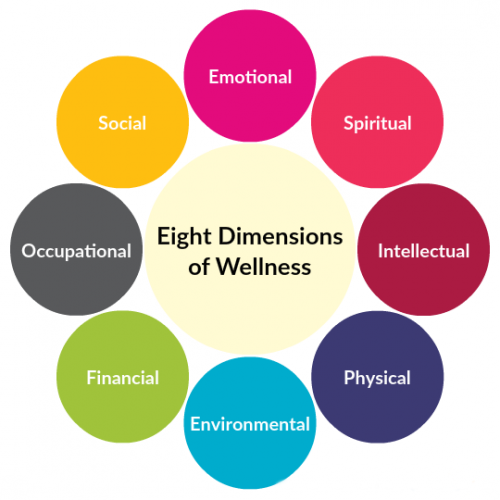This month’s topic is emotional wellness as we continue our series on the eight dimensions of wellness. Emotional wellness is defined as the ability to successfully handle life’s stresses and adapt to change. Healthy habits in the realm of emotional wellness benefit relationships and productivity and decrease stress, enhancing overall wellness in the physical, social, environmental, and occupational dimensions of wellness. Nurturing emotional wellness helps to avoid relationship issues and difficulties at work. It impacts physical and mental health by decreasing risk factors for hypertension, cardiovascular disease, stroke, depression, and anxiety.
Laughter is “good medicine” and has been shown to decrease stress, improve mood, and enhance overall emotional wellness. Connecting with friends who make you laugh or watching funny movies and videos with friends and family connects in the emotional, social, and environmental realms of wellness. Practicing an attitude of gratitude is another way to build positive emotions to balance the challenges of life. A healthy habit of speaking or writing 3 things you are grateful for is a great place to start. Balancing positive and negative emotions is one of the benefits of practicing mindfulness. Focusing on feelings in a non-judgmental way helps us prioritize changing things that fall within our control.
Taking time to self-reflect impacts emotional wellness. Examining things in life that trigger fear and regret helps guide you to personal conflict resolution. Focus your time and energy on areas that require attention for positive change. Develop a self-care routine to provide scheduled space in the day to balance your emotions. A bit of personal quiet time for meditation or a hot bubble bath nourishes the mind and calms the soul. Nurturing resilience helps you bounce back when life does not work as planned and shifts focus to learning from mistakes. Opening growth opportunities by practicing resilience decreases guilt while clarifying a path toward conflict resolution.
Trauma is stored in the brain as memories. Emotions can trigger memories and result in a physical response. Recognizing this mental and physical connection provides coping strategies to help balance both physical and emotional wellness. Loss is a type of trauma with emotional and physical consequences. Coping with loss by sharing thoughts and feelings with a trusted person and listening to others share their emotions builds community and promotes understanding leading to healing.
Prioritizing healthy choices in exercise, nutrition, sleep, and stress management impacts overall emotional wellness. Back to Life Physical Therapy and Coaching Services will assist in processing and prioritizing strategies to find your balance and invest in taking care of yourself! Reach out today for a free consultation.










